2019 KTM 790 Duke Review – First Ride

The long wait is finally over
From the moment the rumor mill first started hinting at KTM developing an 800cc parallel Twin way back in 2014, droves of performance-minded motorcyclists, myself included, have been salivating at the thought of throwing a leg over one. Stuffed into a light, nimble chassis, this engine could power what middleweight fans have been dreaming of for years: A razor-sharp instrument for dissecting any twisty road thrown at it.
2019 KTM 790 Duke
| Engine | 19.0/20 |
| Suspension/Handling | 13.25/15 |
| Transmission/Clutch | 8.5/10 |
| Brakes | 8.5/10 |
| Instruments/Controls | 4.75/5 |
| Ergonomics/Comfort | 9.0/10 |
| Appearance/Quality | 9.0/10 |
| Desirability | 9.5/10 |
| Value | 9.0/10 |
| Overall Score | 90.5/100 |
KTM Developing 500cc And 800cc Twins
KTM 790 Duke Concept Unveiled At EICMA 2016
We US riders have waited through the 2016 EICMA concept unveiling of the KTM 790 Duke, the 2017 product unveiling, the teaser videos, and finally the agony of knowing that the European market would get the bike a full model year before it would cross the Atlantic. We endured the glowing reviews from overseas and bided our time until the 2019 model introduction season rolled around. That time has finally come.
The 2019 KTM 790 Duke is here. Really here – as in, one is parked in my driveway as I type this review. I wish, however, I could say that, after a couple days in the saddle of the 790 Duke, the bike is worth the wait.
Instead, after two days and many miles on some of my favorite SoCal roads, I’m left with a lingering resentment that we could’ve been riding this machine for months. We could’ve logged thousands of miles, had a shootout with its direct competitors, and just maybe, had some shuffling of the 2018 MOBOs. The KTM 790 Duke is so good that it doesn’t make me grateful to finally ride it. It frustrates me that we had to wait so long.
The first of its kind engine for KTM
KTM is known for using Singles and V-Twins – its Duke line consisting of thumpers, while the Super Dukes all utilize 75° V-Twins. Well, the 790 Duke, with its parallel-Twin, breaks the trend. According to KTM, a V-Twin was considered for the 790, but they couldn’t make the package as compact as they wanted to. So, the mill had to have its cylinders side-by-side.
The LC8c (Liquid Cooled 8 Valve compact) engine is exactly what that lowercase C denotes. The engine is visually tiny and appears to be only a smidge larger than the 690 Duke mill. With an 88.0 mm X 65.7 mm bore and stroke, the combined displacement totals 799cc. Because the engine was designed to be quick-revving with minimal vibration, the lightweight forged pistons feature DLC (Diamond Like Carbon) coated piston pins to reduce piston assembly weight and, thus, less reciprocating mass. Similarly, the forged connecting rods are cracked at the big end, providing a unique pattern to the joint, making the faces self-locating and not requiring locating pins – again to save reciprocating mass.
The forged crankshaft has the pins offset by 75° with a 435° firing order to help mimic the sound and character of KTM’s larger V-Twins. The pressure-cast cases are a horizontal split design with the cylinders built into the top case. The cylinders themselves are sleeveless with a Nikasil coating on the aluminum cylinder walls for better cooling and weight savings.
The eight-valve head holds the two chain-driven camshafts, which are kept small (for reduced mass, again) by using DLC-coated finger followers to actuate the valves. While the primary counter-balancer is located down by the crank, a smaller one is gear driven off of the exhaust cam. The importance of engine smoothness can’t be understated in an engine that serves as a stressed member of the frame.
But we’re not to the chassis, yet. We still need to consider how the stacked transmission helps to shorten the engine front to back. Then there’s KTM’s PASC (Power Assist Slipper Clutch), which reduces clutch effort while preventing wheel hop caused by back-torque during aggressive downshifts. However, the most impressive feature of the transmission is the 790’s Quickshifter+ that allows both up- and down-shifts without using the clutch. This is a huge feature on a motorcycle in the 790 Duke’s price range.
Naturally, having the auto-blip capability required for clutchless downshifts means the LC8c has ride-by-wire throttle for the 46mm throttle-bodies. With RbW, the 790 also has four ride modes: Rain, Street, Sport, and Track. Of the four modes, Track is the most tunable with the ability to vary throttle response, traction control, and the anti-wheelie feature.
Along with the quickshifter, the 790 Duke receives an Inertial Measuring Unit (IMU) and a raft of rider aids not typically seen on a middleweight. First, Motor Traction Control (MTC), KTM’s version of traction control, considers the bike’s lean angle when dialing back rear wheel spin via the throttle bodies’ butterfly valves. The Motor Slip Regulation uses the throttle valves in a similar fashion to reduce the back torque caused by abrupt throttle closure or downshifts. Cornering ABS helps the rider to manage braking inputs while leaned over in a curve, giving the rider the maximum traction available without crossing over the line to a slide. Finally, given the style of the 790 Duke, the Supermoto ABS mode should come as no surprise, and it allows for the rear wheel to be locked while still employing the protection of ABS on the front.
A formidable chassis
The tubular, chrome-moly steel frame uses the engine as a stressed member. According to KTM, the frame was tuned to allow the right amount of flex for the riding duties the 790 Duke is expected to be used for. The subframe is a one-piece cast unit and features no covers for weight savings. KTM has employed a unique placement for the airbox intakes. Located entirely between the rails of the subframe, the airbox has its intakes located in the cooler, relatively turbulence-free air behind the rider’s knees.
While the electronics package of the 790 could be considered extravagant for a middleweight bike, the suspension is one area that shows some emphasis on cost savings. The fork offers no adjustments, while the shock has preload only. That said, the fork itself doesn’t look or feel cheap. The 43mm inverted fork uses split functions, with the compression and rebound functions being carried out by different legs. Additionally, the springs are progressively wound with the initial travel being softer to allow for plushness over rough pavement, but the spring rate increases the further into the fork stroke the front wheel travels, delivering a sportily firm ride when the road gets twisty. The shock also has a progressive spring and is adjustable for preload only via a ramped adjuster.
Since the rake is a sporty 24° and the trail is 3.8 in., KTM chose to fit the 790 with a steering damper. In typical riding, KTM set it up so the rider doesn’t even notice its presence until it’s needed.
Braking is handled by a pair of 300mm discs up front. The calipers are radial-mount, 4-piston KTM-branded units manufactured by J.Juan, and we’ve already noted the Cornering ABS. Out back a single 240mm disc and a single-piston caliper handle stopping chores.
Putting it all together
From the moment the starter button is pressed, the 790 lets you know it has a special engine. Even at idle, it feels raucous, with a pleasant burble from the exhaust and the right amount of mechanical noises coming from the engine itself. Blip the throttle, and the rpm climb quickly. The clutch is easy to modulate, while the transmission is snickety-snick into each gear. Since the clutch is so easy to manage, it’s ironic that the rider never has to use it after pulling away from a stop.
Running through the gears with the quickshifter is a joy. Crank on the throttle in first gear, sending the engine lunging towards redline, and all you need to do is lift with your toe to keep the party going. Clutchless downshifts are smooth, though maybe not as smooth as on some other models that really stand out in this regard (I’m thinking the BMW S1000R and its siblings). Still, the downshifts happen when asked and without drama. Charging into a low-speed corner while tapping through downshifts is a hoot. If you want to turn your 790 into a track weapon, you can switch to race shift without needing additional parts. Nice.
However, all is not perfect in quickshift-land. My 790 Duke occasionally missed shifts between second and third gears. This isn’t a once or twice symptom either. It happened about ten times scattered throughout the day. I asked other journalists, and I was the only one who had this issue. A KTM employee rode my bike when I questioned him about the issue and came back saying that it worked fine for him in his 5-minute ride. While I’m open to the possibility that it could be rider error, I tried several different shifting techniques – even to the point of physically moving my toe away from the shifter to make sure that I was allowing it to fully return to center after a shift and still occasionally missed the shift. The symptoms are that the engine cuts out, as it is supposed to, but the shifter doesn’t make the gear selection. If I had to make a guess, I’d say it’s an issue with the return spring not pulling the shift shaft back into its starting position to ready for the next shift.
With that little bit of negativity out of the way, let’s get back to what an entertaining engine the Duke has. The torque curve has 40 lb-ft available at around 2600 rpm and reaches its peak 59.9 lb-ft at 6,600 rpm. The hp curve is pretty dang linear and climbs relentlessly to its peak of 96.2 hp at the 9,000 rev limit. In between, the fuel metering is spot on with almost no abruptness in any throttle transitions. This holds true in both street and sport modes. If the bellow of the engine on the gas isn’t enough for you, wait until you roll off the throttle to tap down through the gears. Here, the engine gives a race-bike-like brat-patta-patta-pat-pat that just screams high-performance. Consider the KTM’s claimed weight without gas being 372.6 lb., add in roughly 26 lb. for fuel, and you’re looking at 96 horses driving a roughly 400-lb. motorcycle! (Unfortunately, due to a technical glitch, I was unable to get the actual weight of the 790, so you’ll have to wait until the inevitable shootout to get the MO-certified weight.)
The only mild fueling miscue is below 2,000 rpm, where the engine has trouble maintaining a neutral throttle. While this is minimal in street mode, sport seems to exacerbate the issue, making me choose street until the city is behind me. However, this is really just a minuscule problem.
And what about the handling? The 790 Duke steers lightning fast without betraying any signs of instability. Simply put, I could place it anywhere I wanted in a corner, and If I changed my mind, say to avoid a rock, the Duke didn’t mind at all. The Maxxis tires fitted to the 790 were developed in conjunction with KTM, and they never complained throughout my sport rides. I am really impressed.
The suspension, despite its lack of adjustability, worked quite well. My experience of it on both broken and smooth pavement was that it did a good job of soaking up the annoying bumps while still transmitting the information I needed from the tires at speed. With my 195 lb. in the saddle, the suspension felt completely balanced fore and aft as I railed through the corners with the only imbalance I felt coming in high-speed banked corners where I encountered a compression bump. In this instance, the back felt like it was squatting more as it absorbed the bump. Immediately afterward, however, the bike regained composure. I know some people will complain about the suspension’s lack of adjustments, but I think KTM made the right choice by spending the money on rider aids, like the quickshifter. Most street riders set their suspension and forget it, while the up/down clutchless shifts are enjoyed over the life of the motorcycle. If you absolutely need adjustable suspenders, KTM will have components in its performance parts catalog, so get your credit cards ready.
What speeds up has to slow down at some point, and once I adjusted to the feel of the brakes, they worked quite well. The front brake lever has a large amount of movement before the binders start doing their job in earnest. While at first blush this may feel like initial softness, I found that I adapted to it in just a few miles. The brakes provided enough feel to comfortably trail brake all the way to the corner’s apex when I chose to. Also, after having a full-boogie panic stop situation on the freeway ride home from the introduction, I can attest to the fact that the Duke will stop Right Now when you ask it to.
The 790 Duke’s riding position is just about perfect for a naked bike of this size and my 5-foot 11-inch frame. The clever handlebar clamps allow for four different bar locations to suit rider preference. My riding position gave my body just enough forward lean to feel comfortable all the way up to about 85 mph. Any higher, and I slid my butt back in the seat to add some more forward lean. The seat is sporting firm but not uncomfortable over the course of a day. Wind protection is non-existent – as you would expect from a naked in which you sit high up on the bike. A little windscreen is available as a factory accessory if you like.
My short time with the 2019 KTM 790 Duke has shown it to be everything I’d ever hoped it would be. As a fan of both parallel-Twins and middleweights, the 790 is the street fighter I have been waiting for. And believe me, I…we…have been waiting for a while. The 790 Duke’s MSRP is $10,499 in your choice of either orange or black. The KTM 790 Duke should be in dealerships before the end of the year. I expect them to sell very well, so you might want to get your deposit in early. Then the wait will finally be over!
2019 KTM 790 Duke
+ Highs
- Torquey, rev-happy engine!
- Clutchless up- and down-shifting
- Light, maneuverable package
– Sighs
- Non-adjustable suspension
- Small-ish tank limits range
- Occasional missed upshifts
In Gear
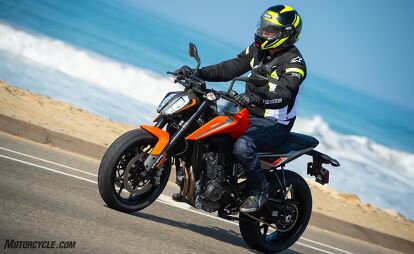
Helmet: Shoei Neotec II Starting at $699
- Jacket: Alpinestars T-Missile Air $600
- Airbag: Tech-Air Race Airbag System $1,150
- Pants: Alpinestars Riffs $300
- Gloves: Reax Jackson $429
Boots: Dainese Torque RS Out Air $390
2019 KTM 790 Duke | |
|---|---|
| MSRP | $10,499.00 |
| Type | 799cc Parallel-Twin |
| Bore and Stroke | 88.0 mm x 65.7 mm |
| Fuel System | DKK Dell’Orto, 46 mm Throttle Body |
| Compression Ratio | 12.7:1 |
| Valve Train | DOHC, 4 valves per cylinder |
| Transmission | 6-speed |
| Final Drive | Chain |
| Front Suspension | WP inverted 43 mm fork, non-adjustable, 5.5 in. travel |
| Rear Suspension | WP Monoshock, preload adjustable, 5.9 in. travel |
| Front Brake | Dual 300 mm discs, radial-mount 4-piston J Juan calipers, ABS |
| Rear Brake | Single 240 mm disc, single-piston J Juan caliper, ABS |
| Front Tire | 120/70ZR17 |
| Rear Tire | 180/55ZR17 |
| Rake/Trail | 24° / 3.8 inches |
| Wheelbase | 58.0 inches |
| Seat Height | 32.5 inches |
| Curb Weight | 372.6 pounds (claimed, dry) |
| Fuel Capacity | 3.7 gallons |
| Available Colors | Orange, black |

Like most of the best happenings in his life, Evans stumbled into his motojournalism career. While on his way to a planned life in academia, he applied for a job at a motorcycle magazine, thinking he’d get the opportunity to write some freelance articles. Instead, he was offered a full-time job in which he discovered he could actually get paid to ride other people’s motorcycles – and he’s never looked back. Over the 25 years he’s been in the motorcycle industry, Evans has written two books, 101 Sportbike Performance Projects and How to Modify Your Metric Cruiser, and has ridden just about every production motorcycle manufactured. Evans has a deep love of motorcycles and believes they are a force for good in the world.
More by Evans Brasfield



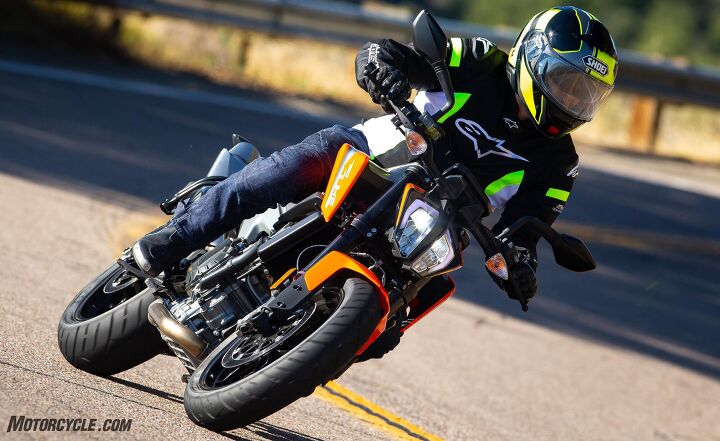




































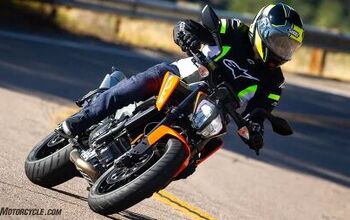
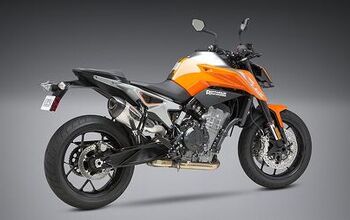

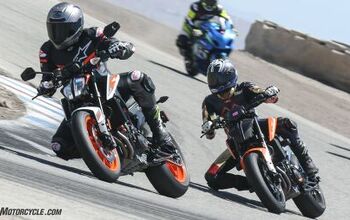
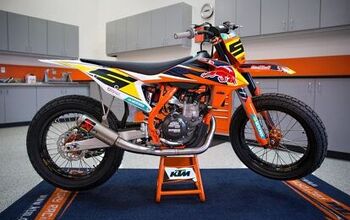











Comments
Join the conversation
Do you think they will make an RC version of this bike?
Can we have a 790 Adventure S please? A 790 Duke GT? Yes, I'll be waiting much longer than Evans B. was complaining about. Either of these would be worth the wait. Could spend longer days in the saddle on either; at 6'2" the Adventure S would fit me better.